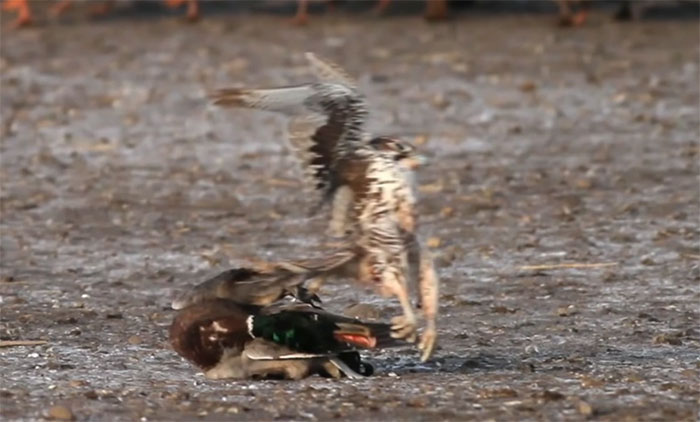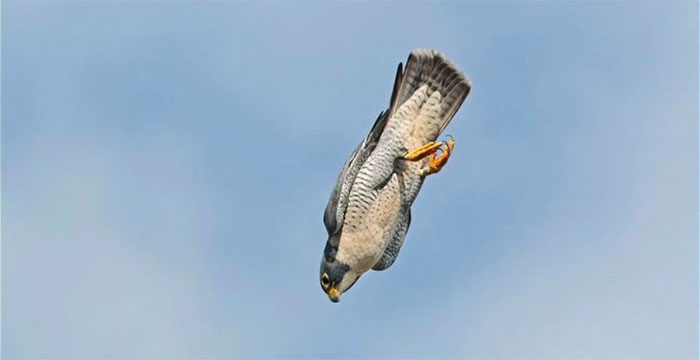The dive of a falcon reaching speeds of up to 90 km/h strikes its target, leaving the wild duck no chance to react, resulting in a swift demise.
There is a saying in folklore, “Quick as a falcon,” which subtly affirms the incredible abilities and speed of falcons in the natural world. The footage clearly illustrates this, showcasing a juvenile prairie falcon effortlessly dispatching a wild duck with a high-speed dive.
This video was recorded in the suburbs of Calgary, a city in southern Alberta, Canada, where large flocks of wild ducks often forage in nearby fields, attracting various predatory birds to the “duck buffet.” In the blink of an eye, a wild duck of the Drake (Mareca americana) species, resting peacefully, suddenly has its head torn apart before it collapses on the ground. Moments later, it is completely unconscious, and the falcon appears to finish the job.

Close-up of the predatory bird’s claws gripping the unfortunate duck’s head and tearing it apart.
Analyzing the video, naturalists measured the falcon’s speed at over 90 km/h during the dive, leaving the victim with no time to react or even realize the presence of its predator. Prairie falcons typically use this hunting method when confronting waterfowl foraging in fields. Clearly, wild ducks are heavier and stronger, so the falcon needs to minimize the animal’s resistance by delivering a direct “punch.”
The prairie falcon (Falco mexicanus) is a bird belonging to the genus Falco in the family Falconidae, found in the western part of North America. They have long, thin, and pointed wings, enabling them to execute high-speed dives from the air.
Thriving in harsh desert environments with low prey density, prairie falcons have evolved into aggressive opportunistic predators capable of hunting both mammals and large birds.
Prairie falcons often fly high to survey the landscape, using their exceptionally good eyesight to spot prey. Once they identify a “unfortunate target,” they quickly swoop down and gradually increase their speed.

The prairie falcon performing a dive from the sky. (Photo: AP).
With the ability to execute dives at speeds of up to 100 km/h from above, prairie falcons are considered one of the most aerodynamically optimized animals in nature, even inspiring human studies for application in jet engines. However, this is not the absolute maximum speed that falcons can achieve. The “king of speed” in this species is the peregrine falcon, which can reach speeds of nearly 400 km/h.
The preferred attack position for falcons is the head or eyes of their prey. By combining extreme speed with sharp talons, the prey is often stunned and unconscious after the impact delivered by the falcon.
Once gaining this advantage, the prairie falcon slowly approaches, using its talons and hooked beak with a sharp projection (referred to as a tooth) capable of breaking the spine and tearing flesh from the prey.
In nature, falcons are positioned near the top of the food chain, with very few natural enemies. However, there have been instances where falcons have been hunted and killed by larger predatory birds, such as great horned owls.


















































